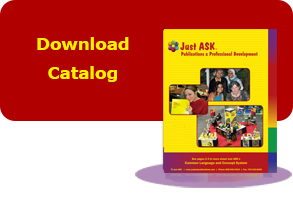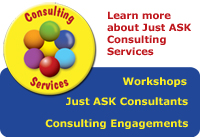
January 2016
Volume XII Issue XI
Share this newsletter on
Ten Trending Topics and Resources Impacting Our Practice 2016

Bruce Oliver, the author of Just for the ASKing!, lives in Burke, Virginia. He uses the knowledge, skills, and experience he acquired as a teacher, professional developer, mentor, and middle school principal as he works with school districts across the nation. He has written more than 150 issues of Just for the ASKing! He is also a co-author of Creating a Culture for Learning published by Just ASK.
A trend is defined as a general direction in which something is developing or changing. Some trends have a momentary life span during which they gain a flurry of attention but then fizzle out. Other trends maintain an interest and gather audiences over time and show some promise of having an impact on our professional lives. Below you will find ten trending topics and resources that educators are talking about and using.
Edutopia Resources (www.edutopia.org)
Edutopia has become the “go to” site for staying on top of instructional innovations. Funded by the George Lucas Foundation, the site provides an array of resources including video clips that are well-produced and extremely useful. The Edutopia website is easy to navigate and enables visitors to browse topics, preview videos or join conversations. A separate section titled “New Stuff” addresses a wide assortment of topics such as critical thinking and professional development.
Google Apps for Education (www.google.com/edu/)
According to Edudemic, the most popular tools available to both teachers and students are the Google Apps for Education. It is estimated that 40 million students and educators across the world use this suite of apps. Among the options that Google offers are Classroom, Gmail, Drive, Calendar, Vault, Docs, Sheets, Slides and Sites. Tag lines on the Google website include the following: Take Gmail to school, Streamline your class, Collaborate on documents, Share in the cloud, Share calendars, Create websites, Meet face to face, Add on social apps, and Archive your emails and chats. The Google site provides demonstrations of the apps and access to additional information about each app.
Impact of Poverty
It should come as no surprise to most educators that the impact of poverty continues to be a newsworthy topic for practitioners. In January 2013, and updated in January 2015, the Southern Education Foundation issued a report that stated that low-income students became a majority in the nation’s public schools with nearly 50 million students qualifying for free or reduced-price meals. Educators have for decades done a yeoman’s job of providing support for poor children and have played a life-changing role in their lives. Since the statistics on poverty emerged, increased attention has been paid to ways to support impoverished students in our schools. Author and brain researcher Eric Jensen provides up-to-date insights in his latest book, Teaching With Poverty in Mind: Practical Strategies for Raising Achievement. Jensen’s suggestions include the following:
- Make sure to include physical activity such as movement, recess and games since they lead to greater oxygen intake and improved learning
- Include vocabulary building enrichment experiences in a relentless manner
- Consistently strengthen relationships with students by revealing more about yourself and learning more about the lives of students
- Recognize effort every day
- Convince students that their brains can change and grow and that they can become “smarter”
- Devote time to establishing “laser-targeted skill building” that students need most including core academic skills, as well as organization and study skills
- Be the strong, caring, positive adult that might be missing from children’s lives outside of school
- Reduce stress by including fun activities connected to academic learning.
Jensen notes obstacles that impede success in working with poor students include lack of buy in by staff, “paralysis by analysis” when plans are too large and overwhelming, and lack of a unified and relentless focus. He writes, “Remember students in poverty are not broken or damaged. In fact, human brains adapt to experiences by making changes – and your students can change.”
Student Engagement
The topic of student engagement continues to dominate conversations among educators. New information and insights provide reminders about practices that have shown promise in engaging young people more intently in their learning. Students will become more committed to their learning when
- They are intellectually, emotionally, behaviorally, socially, and culturally engaged in learning
- The culture of the classroom includes conversations and different points of view rather than a focus on providing the right answer.
- Students are able to improve the quality of their work by following a draft and revision process.
- Students can connect content to the world beyond the classroom.
- Teachers develop a repertoire of strategies from which they can choose to maintain a learner-centered classroom.
In addition to these established insights, educational neuroscience expert David Sousa recently published Engaging the Rewired Brain in which he writes about how the human brain develops throughout childhood and adolescence. Sousa provides evidence-based guidance and specific strategies to employ with “technology-addicted learners.” He writes, “Today, the attractions and distractions of digital devices and other technologies complicate the task of intellectually engaging students.” His work suggests instructional shifts to help teachers determine whether, when and how to use technology to “stimulate students’ curiosity and interests.”
Game-Based Learning
Many students as well as adults spend their leisure time playing video games. It can represent the ultimate in total engagement, as the player is thoroughly transfixed as he tries to successfully complete the game’s challenge. In The Game Believes in You: How Digital Play Can Make Our Kids Smarter author Greg Toppo writes that games “focus, inspire and reassure in ways that teacher can’t. Games give people a chance to learn at their own pace, take risks, cultivate deeper understanding, fail and want to try-again-right-away and ultimately succeed in ways that too often elude them in school.” In recent months, more and more teachers have been exploring the option of adding game-based learning to their repertoires of methods to involve their students more deeply in academic endeavors. eSchool News has published a series of articles that help educators access what research says about the use of gaming, what studies have concluded about the use of gaming as a learning strategy, how to successfully incorporate gaming into instructional delivery, and how to better ensure that the inclusion of gaming has true educational value. Articles that appear on the eSchool News website include the following titles:
- Gaming Has Huge Educational Potential
- Bill Gates: Why Game-based Learning is the Future of Education
- How Game Mechanics Can Revitalize Education
- Game-based Learning Catching on in Schools
- How to Engage Girls in Gaming
Additionally, Edutopia provides a Game-Based Learning Resource Roundup that includes tips, resources, videos and information about the principles of game design and the connection to the learning process.
Social Competence
The headline in the USA Today article read: Kids’ Social Competence Key to Success. The lead line in the story read: “Parents who want their kids to succeed have been known to play Mozart in the nursery and quiz their preschoolers with flash cards. A new study suggested these parents might want to go back to the basics by teaching their children to share and take turns.” According to a 20-year study of over 750 children, kindergartners with strong social and emotional skills were more likely than their peers to succeed academically and professionally in their post-education world. In the study, social competence involved making friends, cooperating, resolving conflicts, listening to others’ points of view, and giving suggestions without being bossy. Children with weaker social skills were less successful in later life than their peers. Additionally, other studies have also pointed to the importance of early childhood development in shaping the brain and later behavior.
Teacher-Led Schools/Teacher-Powered Schools (www.teacherpowered.org)
A trend that is gaining momentum across the country is the idea of teacher-led schools. The concept is defined as a school that is collaboratively designed and implemented by teachers by having the collective autonomy to make decisions about the success of a school and its professional endeavors. According to the Teacher-Powered Schools website, more than 70 schools in 15 states are currently operating; 85% of parents and 78 % of teachers surveyed think the practice is a good idea. In a recent Huffington Post article titled “Ways Teacher-Powered Schools Are Transforming American Public Education,” author Kim Farris-Berg posits five ways that the concept is changing schools for the better:
- Teachers identify students’ needs and design schools to address those needs. School leaders are chosen by teachers who work to support teacher teams’ decisions
- Both teacher and student learning is more personalized through innovative approaches, different uses of time, and coaches to support both students and teachers
- Since teachers are responsible for the success of the school, they focus on what is best for students and when something is not working, they fix it more quickly
- Teachers trust their colleagues and are more likely to take chances and apply new ideas since they do not feel that their job security is threatened by an imposed evaluation process
- Teachers look beyond standardized tests and advance more fresh ideas about student achievement and assessment
Deeper Learning
There is a strong movement to have students learn at deeper levels. The adoption of revised and more rigorous state standards has led to more complex tasks representing what students would do as they learned. Verbs associated with the standards include articulate, hypothesize, collaborate, conceptualize, manipulate, create, delineate, elaborate, exemplify and critique. Teachers have been challenged to devise learning experiences that cause students to engage in work that promotes student thinking in these ways.
Deeper learning is defined by the Hewlett Foundation as “mastery of core academic content, critical thinking, problem solving, collaboration, effective communication, self-directed learning, and an academic mindset.” In order to bring life to the definition, practitioners are implementing a variety of instructional approaches including STEM, project-based learning, Depth of Knowledge, and the Rigor and Relevance Framework. As students are challenged to learn more deeply, they must learn to think in different ways. In short, they must go even beyond thinking about their thinking and engage in metacognitive thinking. Dr. Brian Mandell, a science curriculum developer at the Smithsonian Science Education Center provides a list of strategies we can use to help students develop their metacognitive skills. Possibilities include:
- Model coping strategies, make mistakes, and show students how you persevere in the face of adversity (Use Think Alouds)
- Ask students to discuss how they approach problems
- Create reminder checklists
- Engage in self-questioning
- Generate annotated drawings
- Use reciprocal teaching
In addition, Just ASK consultant and elementary principal Heather Clayton writes extensively about the mind shifts that teachers and students have made in the Just ASK e-newsletter Making the Common Core Come Alive! Through vivid descriptions and strong exemplars, Heather paints a clear picture showing how teachers and students have achieved success as they transitioned into deeper thinkers.
Formative Assessment
The literature continues to be replete with information about and questions that have arisen from the research of Paul Black and Dylan William on the topic of formative assessment. Researchers have concluded that “there is a body of firm evidence that formative assessment is an essential component of classroom work and its development can raise standards of achievement.” As teachers grapple with research findings and best practices surrounding the topic, they are trying to determine what changes need to be made in their day-to-day practices. Education Week recently published a series of articles titled “Understanding Formative Assessment” which shed light on some of the pressing questions. One such question is “Should formative assessments be graded?” Black and William concluded that they should not be graded since the basic purpose of formative assessments is to provide students with feedback so that they can learn from their mistakes and improve their performance on summative assessments. This practice can be sometimes be difficult to implement because some districts have policies that require teachers to post a certain number of grades on a regular basis.
Suggested practices that emerged from the article include the following:
- Before posting a grade, give students feedback on their submitted work, let students reflect on and revise their work and then show students their improved grade
- Explain to students that the posted grades are for “information purposes” and will not “count” on a final report grade; the teacher can still provide narrative comments or hold face-to-face conferences with students to provide feedback
- Rename posted formative assessment grades as “as if” grades, meaning the grade the students would have gotten if the assignment had been a “finished product;” students still receive feedback and better understand the criteria for good work
- Tell students that the posted grades are temporary and are for the purpose of “practice and revision”
The Online World Beyond Google Apps
Beyond Google Apps for Education, the tools most often being used by teachers are:
- Twitter (growing a personal learning network – PLN)
www.twitter.com - You Tube (multiple channels for educators)
www.youtube.com - Edmodo (Free all-in-one learning platform)
www.edmodo.com - Remind (combination of sticky notes and class newsletter for the digital age)
www.remind.com - WordPress (provide opportunities for a classroom blog which engages students)
https://wordpress.com - Evernote (share information with students and substitute teachers, organize lesson plans, and jot down ideas)
https://evernote.com - EDPuzzle (transform a video into a lesson)
https://edpuzzle.com - Easel.ly (create custom infographics)
www.easel.ly - Dropbox (cloud storage device)
www.dropbox.com -
Online Classroom Video Clips and More
Many major companies and organizations that support education no longer produce and sell videos since so many are available at no charge on the Internet. Sources of note include:- Edudemic provides an annotated list of “The 100 Best Video Sites for Educators.” The videos are sorted into categories titled: General Video Collections, Teacher Education, Lesson Planning, Science, Math and Technology, History, Arts, and Sciences, Video Tools, Network and Program Videos, Free Movies and Clips, How To’s, and Government and Organizations.
www.edudemic.com/best-video-sites-for-teachers
- Teaching Channel’s mission is to create an environment where teachers can watch, share, and learn new techniques to help every student grow. There are inspiring classroom clips that provide strong examples for every grade and content area.
www.teachingchannel.org - Khan Academy’s site notes that it provides practice exercises, instructional videos, and a personalized learning dashboard that empower learners to study at their own pace in and outside of the classroom. Additionally, Khan Academy has teamed with College Board to offer free tutoring for SATs. The math clips featuring LeBron James are sure winners.
www.khanacademy.org
- Colorin Colorado’s site features classroom videos that demonstrate best practice in the instruction of English language learners (ELLs). Supporting resources are included so that the clips can be used for professional development.
www.colorincolorado.org
- Edudemic provides an annotated list of “The 100 Best Video Sites for Educators.” The videos are sorted into categories titled: General Video Collections, Teacher Education, Lesson Planning, Science, Math and Technology, History, Arts, and Sciences, Video Tools, Network and Program Videos, Free Movies and Clips, How To’s, and Government and Organizations.
Resources and References
Bakken, Carrie. “What It’s Like to Teach in a Teacher-Led School.” Ed Week Teacher. Access at www.edweek.org/tm/articles/2015/02/18/what-its-like-to-teach-in-a.html, February 2015 Bellanca, James, Editor. Deeper Learning: Beyond 21st Century Skills. Milwaukee, WI: Boswell Book Company, 2014 Black, Paul and Dylan Wiliam. “Inside the Black Box: Raising Standards through Classroom Assessment.” Phi Delta Kappan 80(2), pp 139-148, 1998 Clayton, Heather. Making the Common Core Come Alive! e-newsletter. Just ASK Publications. Access at www.justaskpublications.com/just-ask-resource-center/e-newsletters/mccca Farris-Berg, Kim. “5 Ways Teacher-Powered Schools Are Transforming American Public Education.” Huffington Post. Access at www.huffingtonpost.com/kim-farrisberg-/teacher-powered-schools_b_5613420.html, 2014 “Game-Based Learning Resource Roundup.” Edutopia. Access at www.edutopia.org/game-based-learning-resources, 2011, updated 2015 Jensen, Eric. Teaching with Poverty in Mind: What Being Poor Does to Kids’ Brains and What Schools Can Do About It. Alexandria, VA: ASCD, 2009 ________. Engaging Students with Poverty in Mind: Practical Strategies for Raising Achievement. Alexandria, VA: ASCD, 2013 Jones, Damon, Mark Greenberg and Max Crowley. “How Children’s Social Competence Impacts Their Well-Being in Adulthood: Findings from a 20-Year Study on the Outcomes of Children Screened in Kindergarten.” Robert Wood Johnson Foundation. American Journal of Public Health, July 2015. Access an overview at www.rwjf.org/content/dam/farm/reports/issue_briefs/2015/rwjf421663. Access full report at https://ajph.aphapublications.org/doi/pdf/10.2105/AJPH.2015.302630 Mandell, Brian. “Good Thinking: That’s So Meta(cognitive).” STEMvisions Blog. Smithsonian Science Education Center. Access at Martinez, Monica and Dennis McGrath. Deeper Learning: How Eight Innovative Public Schools Are Transforming Education in the Twenty-First Century. New York City, NY: The New Press, 2014 Sousa, David. Engaging the Rewired Brain. West Palm Beach, FL: Learning Sciences International, 2015 Stansbury, Meris. “Can Gaming Change Education?” eSchool News. Access at Suitt, Steve. Research Bulletin: A New Majority – Low Income Students Now a Majority In the Nation’s Public Schools. Southern Education Foundation, January 2015. Access at www.southerneducation.org/getattachment/4ac62e27-5260-47a5-9d02-14896ec3a531/A-New-Majority-2015-Update-Low-Income-Students-Now.aspx Toppo, Greg. The Game Believes in You: How Digital Play Can Make Our Kids Smarter. New York City, NY: Macmillan-St. Martin’s Press, 2015 “The 100 Best Video Sites for Educators.”Access at www.edudemic.com/best-video-sites-for-teachers/ “Understanding Formative Assessment: A Special Report.” Education Week. Access at www.edweek.org/ew/collections/understanding-formative-assessment-special-report/index.html www.hewlett.org/programs/education/deeper-learning www.hewlett.org/uploads/documents/Deeper_Learning_Defined__April_2013.pdf |
Permission is granted for reprinting and distribution of this newsletter for non-commercial use only. Please include the following citation on all copies:
Oliver, Bruce. “Ten Trending Topics and Resources Impacting Our Practice 2016.” Just for the ASKing! January 2016. Reproduced with permission of Just ASK Publications & Professional Development (Just ASK). © 2016 Just ASK. All rights reserved. Available at www.justaskpublications.com.



